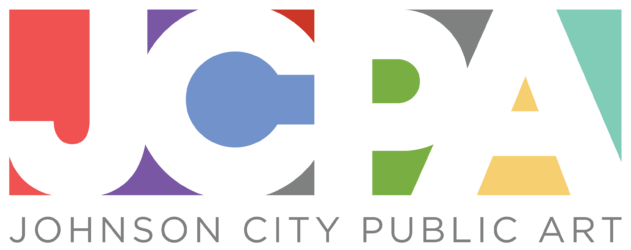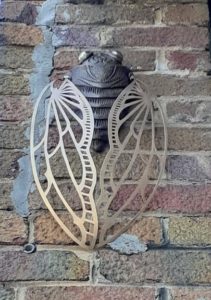Click to view larger image
Hanna Jean Traynham is a graduate student in the Department of Art & Design at ETSU who accepted the challenge to create a bronze sculpture for the “Wildabout Walkabout” project. Though she’s a ceramics artist, Hanna found it relatively easy to translate her work from clay into bronze. She has years of experience using heat in her work and discovered similarities between bronze casting and wood-fired ceramics.
The design for Hanna’s cicada sculpture was inspired by art deco architecture—simple, clean geometric forms with ornamental and stylized elements often inspired by nature and non-western sources (Egyptian, Asian and Native American art in particular).
After creating a design to scale, Hanna built a clay model then let it dry until it was leather-hard. From her model, she created a (heat-proof) silicone mold into which she poured the hot wax. When it cooled and hardened, the model was coated in ten to twelve coats of clay slurry interspersed with very thin coats of a sand and silica mixture. (If you’ve ever made fried green tomatoes, you’ll understand this process.) The model was allowed to dry between coats of slurry, then set aside at the end of the process to dry “for a long time.”
Many of the artists and faculty pitched in to help each other during the long process of creating the sculptures. Clay is a very familiar material for Hanna, who helped other artists with their slurry coats. She has been making ceramics for as long as she can remember; after years of making things out of mud, it was a revelation when she was first introduced to pottery in 3rd grade. Hanna earned her BFA in Studio Arts at James Madison University in Harrisonburg, Virginia with a concentration in ceramics.
On a day set aside for casting the sculptures, Hanna and others suited up in goggles, face shields, gloves and other gear along with sculpture professor Travis Graves, who supervised the casting process in addition to overseeing the entire project. After pushing the six sculptures that were being cast that day deep into a large sand pit, a bucket of glowing liquid bronze was brought out. Funnels had been built into the molds to direct the flow of molten metal, which was poured quickly into the molds.
Hanna’s sculpture remained in the sand pit for a day or so until it had cooled. When she lifted her cicada out of the sand, it looked like the same object, but much heavier. Clean up of the model is a long but critical part of the process. After breaking off the clay shell using a hammer or something similar, the piece looked as if it was covered in mud. Hanna had to grind down the excess and any sharp pieces. She used a hammer and chisel to remove clay from the textured details, which was a very labor-intensive process. From there, she used a buffing and polishing machine to smooth the surface. She polished the cicada’s eyes to a high sheen, which makes it seem as if they are glowing.
The final steps in bronze casting usually involve the application of a patina and protective coating to the object. For the cicada, however, there was one more task—making the wings. Hanna spent her winter break from ETSU on the cicada’s wings, an arduous activity that took approximately 32 hours to complete. The wings look as if they’ve been etched with a laser but, in fact, Hanna cut the wings by hand from a sheet of bronze using a jeweler’s saw borrowed from the jewelry instructor. Finally, a copper rod was inserted into holes in the sculpture and the wings were attached by rivets.
This was Hanna’s first attempt at bronze casting but it proved to be a gratifying medium for artists like her who enjoy a process-driven art form where each of the many steps is essential to make the work a success. A certain amount of problem-solving often accompanies each of those steps. It was a long, labor-intensive process but being a part of this public art project will allow many people to see her work. Hanna expects to graduate from ETSU in Spring 2022 with an MFA in Studio Art with a focus in Ceramics, after which she will be looking for a teaching position.


